Demographic history of Kosovo
This article includes information on the demographic history of Kosovo.
Prehistory and Antiquity
The region was originally inhabited by Thracians,[1][2] and subsequently by Illyrians and Celts.[3][1] During antiquity, the area was inhabited by the Dardani and by the fourth century BC the Dardanian Kingdom was founded.
According to Ancient Greek historian Strabo, the Dardanians were Illyrians and he included them as part of the Illyrian world in his geography.
The Dardani, whose exact ethno-linguistic affiliation is difficult to determine, were a prominent group in the region during the late Hellenistic and early Roman eras.[4] The area was originally populated with Thracians who were then exposed to Illyrian influence.[2][5] After Roman conquest of Illyria in 168 BC, Romans colonized and founded several cities in the region, such as Ulpiana, Theranda and Vicianum,[6] later incorporating it into the Roman province of Illyricum in 59 BC. Subsequently, it became part of Moesia Superior in AD 87. The region was exposed to an increasing number of 'barbarian' raids from the 4th century AD onwards, culminating with the Slavic migrations of the 6th and 7th centuries. Archaeologically, the early Middle Ages represent a hiatus in the material record.[7]
The region, together with the rest of the Balkans, saw a massive invasion of Slavic tribes around 500-600 AD. Byzantine scholar Procopius, who lived at the time, in his book, History of the Wars, Book VII, described how the Slavs invaded the Balkans, pillaged, enslaved and killed it's native Illyrian and Thracian population. [8]
According to other sources, the plague of Justinian had killed millions of native Balkan people and as a result many regions had become depopulated and neglected by the government, this gave the Slavs a chance into raiding and settling in the Balkans. [9]
Early and High Middle Ages
The region had been part of the Roman and the Byzantium until the first major Slav raids took place in the middle of Justinian's reign. In 547 and 548 the Slavs invaded the territory of modern Kosovo, and then got as far as Durres on the Northern Albanian coast and reached all the way down to Greece.[10]
Although the Balkans had been raided by Slavic tribes, the early Slavic settlement and power in Kosovo was not big, [11] until the region was later absorbed into the Bulgarian Empire in the 850s, where Christianity and a Byzantine-Slavic culture was cemented in the region. After the collapse of the Bulgarian Empire , the Region became later again part of the Byzantine Empire after the empire fully re-established itself and would stay under Byzantine rule for nearly two centuries after that [12] until later Serbian Grand Prince Stefan Nemanja, who had expanded his empire south and into Kosovo conquered it by the end of the 12th century. [13]
According to Serbian scholars, although Albanians lived between Lake Skadar and the Devoll river in the 1100s, Albanian migration into the plains of Metohija (Albanian: Dukagjin) commenced at the end of the century. [14] Some of the arriving Albanians were assimilated by Serbs and Montenegrins. [15] Several Albanian personal names and placenames appear in various parts of Kosovo and North Macedonia in the 13th century, the first identifiably Albanian place name appearing in Kosovo, attested in a 1253 statement by Serbian knez Miroslav.[15] By 1330, the frequency of identifiably Albanian names in a 1330 chrysobull describing estates in Decan is "many", although attempts to ascertain reliable percentages of the Albanian population relative to Serbs at this period or later are described by Madgearu as "difficult".[15]
The presence of Vlach villages in the vicinity of Prizren is attested in 1198–1199 by a charter of Stephan Nemanja.[16]
According to Ducellier and Noel Malcolm, part of the Albanian population in Kosovo is from a pre-Ottoman Albanian population within the Kosovo region itself that had expanded. This especially given that there is no evidence of any large Albanian migrations into Kosovo up until the 16th-17th century. [17] [18]
According to Noel Malcolm, except for migrations from Northern Albania, large parts of the Albanian demographic growth in Kosovo was the expansion of a native Albanian population within the Kosovo region itself. [19]
Bosnian historian Hanzic and Croatian scholar Milan Sufflay also concluded the same thing, that part of the Albanian population in Kosovo, such as the Western part of Kosovo, was from an old native population. [20] [21]
9th-13 century
Bulgarian Rule
Between ca. 830 and ca, 1015 the region was Bulgarian. According to Richard J. Crampton, the development of Old Church Slavonic literacy during the 10th century had the effect of preventing the assimilation of the South Slavs into the Byzantine culture, which promoted the formation of a distinct Bulgarian identity in that area.[22] Afterwards it was ceded to the Byzantine empire as a province called Byzantine Bulgaria.
Byzantine Rule
In 1072 an unsuccessful rebellion led by local Bulgarian landlord Georgi Voiteh arrose in the area and in 1072 in Prizren he was crowned "Tsar of Bulgaria". At the end of the 11th century the Byzantine domains in the Balkans became an arena of fierce hostilities. At the end of the 12th century, formally Byzantium was still the sovereign. The disintegration of Byzantium was complete when in 1204 the Fourth Crusade captured Constantinople.
14th century
1321–31
The Dečani chrysobulls (1321–31) of Serbian king Stefan Dečanski contains a detailed list of landholdings and tax farming rights which the monastery of Visoki Dečani held over an area which spanned from southern Serbia (modern Sandzak), Kosovo, Montenegro and parts of northern Albania. The chrysobulls were signed by King Stefan Uroš III Dečanski of Serbia who confirmed existing rights and gave new ones to the monastery. The chrysobulls listed that Visoki Dečani held tax farming rights over 2,097 households of meropsi (dependent farmers-serfs), 266 Vlach households (pastoral communities) and 69 sokalniki (craftsmen).[23]
In the 14th century in two chrysobulls or decrees by Serbian rulers, in the villages of modern-day Kosovo area, find Serbs living alongside Albanians and Vlachs, who are cited in the first as being between the White Drin and Lim rivers (1330). In the second Serbian golden bull (1348) a total of nine Albanian villages are cited within the vicinity of Prizren.[24][25]
During this period one can also witness a Serbianisation or Slavicization of the Albanian population in Kosovo, with some Albanians carrying Serbian names and converting to Orthodoxy. [26]
15th century
1455
The Ottoman cadastral tax census (defter) of 1455 in the Branković lands (covering most of present-day Kosovo) recorded:
- 480 villages,
- 13,693 adult males,
- 12,985 dwellings,
- 14,087 household heads (480 widows and 13,607 adult males).
Yugoslav and Serbian scholars have researched the defter, concluding that:[27]
- 13,000 Serb dwellings present in all 480 villages and towns
- 75 Vlach dwellings in 34 villages
- 46 Albanian dwellings in 23 villages
- 17 Bulgarian dwellings in 10 villages
- 5 Greek dwellings in Lauša, Vučitrn
- 1 Jewish dwelling in Vučitrn
- 1 Croat dwelling
Out of all names mentioned in this census, conducted by the Ottomans in 1455, covering areas of most of present-day Kosovo, 95.88% of all names were of Slavic origin, 1.90% of Roman origin, 1.56% of uncertain origin, 0.26% of Albanian origin, 0.25% of Greek origin, etc.[28][29]
However, while Serbian scholars may have come to the conclusion that the defter indicates an overwhelmingly Serbian local population, other scholars have other views. Madgearu instead argues that the series of defters from 1455 onward "shows that Kosovo... was a mosaic of Serbian and Albanian villages", while Prishtina and Prizren already had significant Albanian Muslim populations, and that the same defter of 1455 indicates the presence of Albanians in Tetovo[30] (just across the border in North Macedonia).
1487
The defter of 1487 in the Branković lands recorded:
- Vučitrn district:
- Peć District:
- Peć (town)
- 121 Christian households
- 33 Muslim households
- Suho Grlo and Metohija:
- 131 Christian households, of which 52% in Suho Grlo were Serbian
- Donja Klina – 50% Serbian
- Deçan – 64% Serbian
- Rural areas:
- 6,124 Christian households (99%)
- 55 Muslim households (1%)
Scholarship on Kosovo has encompassed Ottoman provincial surveys that have revealed the 15th century ethnic composition of some Kosovo settlements. However, both Serbian and Albanian historians using these records have made much of them while proving little.[31]
16th century
1520–1535
- Vučitrn: 19,614 households
- Christians
- 700 Muslim households (3.5%)
- Prizren
- Christians
- 359 Muslim households (2%)
1582–83
The 1582–83 defter of the Sanjak of Scutari recorded the Peć nahiya as having 235 villages of which some 30 have Albanian families lived besides the majority populated villages containing Orthodox Serbs. The Altun-li nahiya had 41 villages with a Serb majority and Albanian minority.[32]
17th–18th centuries
Significant clusters of Albanian populations lived in Kosovo especially in the west and centre before and after the Habsburg invasion of 1689–1690, while in Eastern Kosovo they were a small minority.[34][35] Due to the Ottoman-Habsburg wars and their aftermath, some Albanians from contemporary northern Albania and Western Kosovo settled within the wider Kosovo area in the second half of the 18th century, at times instigated by Ottoman authorities.[36][37]
Successive persecutions of Serbs by the Ottomans in the southern Balkans resulted in migrations to areas under the control of the Habsburg Monarchy, in particular during the Great Turkish War of 1683–1699.[38] During that war between the Ottomans and the Habsburgs, it led to the flight of a substantial numbers of Serbs and Albanians who had sided with the Austrians, from within and outside Kosovo, to Austrian held Vojvodina and the Military Frontier – Patriarch Arsenije III, one of the refugees, referred to 30,000 or 40,000 souls, but a much later monastic source referred to 37,000 families. Serbian historians have used this second source to talk of a Great Migration of Serbs. Wars in 1717–1738 led to a second exodus of refugees (both Serbian and Albanian) from inside and outside Kosovo, together with reprisals and the enslavement and deportation of a number of Serbs and Albanians by the victorious Ottomans.[39]
During the Great Austro-Turkish War, Albanian Catholic leaders Pjetër Bogdani and Toma Raspasani rallied Kosovo Albanian Catholics and Muslims to the pro-Austrian cause. After the war, when Kosovo did not end up part of the Habsburg empire, harsh reprisals followed. Large numbers of Catholics[40] and Serbs[41] fled north where many "died, some of hunger, others of disease" around Budapest.[40] After the flight of Serbs, the İpek Detachment forced Catholic Albanians in the north to move to the now depopulated plains of southern Serbia, and forced them to convert to Islam there.[41]
According to Noel Malcolm, the Albanians that were forced and settled by the Ottomans were mainly the Catholic Kelmendi tribe from the mountains of Northern Albania that had rebelled and held raids against the Ottomans. As a result, the Ottomans forcibly settled them in the plains to control them better. Many of these families returned to Northern Albania while some stayed. [42]
Many Albanian Catholic families from the North Albanian mountains migrated after the 17th century into Kosovo and many of these families fled blood feuds or to find better land and make space for a bigger population, many of these families also converted to Islam in the Kosovo region. However, there is no evidence of any large Albanian migrations into Kosovo up until the 17th century. Many scholars have concluded therefore also that the growth of the Albanian population in Kosovo was also largely due to the expansion of an indigenous Albanian population within the Kosovo region itself. [43]
19th century
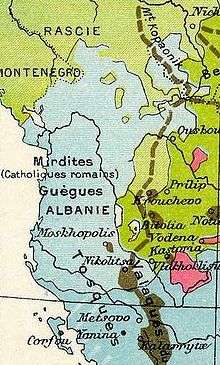
Kosovo was part of the Kosovo Vilayet, which included Kosovo, parts of northern and northwestern North Macedonia, parts of modern eastern Montenegro and much of the Sandzak region. 19th century data about the Kosovo Vilayet tend to be rather conflicting, giving sometimes numerical superiority to the Serbs and sometimes to the Albanians. The Ottoman statistics are regarded as unreliable, as the empire counted its citizens by religion rather than nationality, using birth records rather than surveys of individuals.
A map published by French ethnographer G. Lejean[44] in 1861 shows that Albanians lived on around 57% of Kosovo Vilayet while a similar map, published by British travellers G. M. Mackenzie and A. P. Irby[44] in 1867 shows slightly less; these maps don't show which population was larger overall. Nevethless, maps cannot be used to measure population as they leave out density.
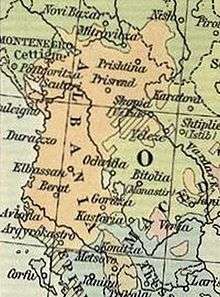
Modern Serbian sources estimated that around 400,000[45] Serbs were cleansed out of the Vilayet of Kosovo between 1876 and 1912.
Maps published by German historian Kiepert[44] in 1876, J. Hahn[44] and Austrian consul K. Sax,[44] show that Albanians live on most of the territory of what is now Kosovo, however they don't show which population is larger. According to these, the regions of Kosovska Mitrovica and Kosovo Polje were settled mostly by Serbs, whereas most of the territory of western and eastern parts of today's province was settled by Muslim Albanians.
An Austrian statistics[46] published in 1899 estimated about the population of the Kosovo Vilayet:
During and after the Serbian–Ottoman War of 1876–78, between 30,000 and 70,000 Muslims, mostly Albanians, were expelled by the Serb army from the Sanjak of Niș (located north-east of contemporary Kosovo) and fled to the Kosovo Vilayet.[47][48][49][50][51][52] Serbs from the Lab region moved to Serbia during and after the war of 1876 and incoming Albanian refugees (muhaxhirë) repopulated their villages.[53] Apart from the Lab region, sizeable numbers of Albanian refugees were resettled in other parts of northern Kosovo alongside the new Ottoman-Serbian border.[54][55][56] Most Albanian refugees were resettled in over 30 large rural settlements in central and southeastern Kosovo.[53][55][57] Many refugees were also spread out and resettled in urban centers that increased their populations substantially.[58][55][59] Western diplomats reporting in 1878 placed the number of refugee families at 60,000 families in Macedonia, with 60-70,000 refugees from Serbia spread out within the vilayet of Kosovo.[60] The Ottoman governor of the Vilayet of Kosovo estimated in 1881 the refugees number to be around 65,000 with some resettled in the Sanjaks of Üsküp and Yeni Pazar.[60]
In the late Ottoman period, Kosovo vilayet contained a diverse population of Muslim Albanians and Orthodox Serbs that was split along religious and ethnic lines.[61]
Muslim Albanians formed the majority of the population in Kosovo vilayet that included an important part of the urban-professional and landowning classes of major towns.[62] Western Kosovo was composed of 50,000 inhabitants and an area dominated by the Albanian tribal system with 600 Albanians dying per year from blood feuding.[63] The Yakova (Gjakovë) highlands contained 8 tribes that were mainly Muslim and in the Luma area near Prizren there were 5 tribes, mostly Muslim.[61] The population of the tribal areas were composed of Kosovar Malisors (highlanders).[61] The town of İpek had crypto-Christians who were of the Catholic faith.[61]
Muslim Bosniaks whose native language was Slavic formed a sizable number of Kosovo vilayet's population and were concentrated mainly in Yenipazar sanjak.[62] Circassian refugees who came from Russia were resettled by Ottoman authorities within Kosovo vilayet in 1864, numbering some 6,000 people by the 1890s.[62]
In the northern half of Kosovo vilayet Orthodox Serbs were the largest Christian group and formed a majority within the eastern areas.[62] Several thousand Aromanians inhabited Kosovo vilayet.[62] Bulgarians lived in the southern half of Kosovo vilayet.[62]
Ottoman provincial records for 1887 estimated that Albanians formed more than half of Kosovo vilayet's population concentrated in the sanjaks of İpek, Prizren and Priştine.[61] In the sanjaks of Yenipazar, Taşlica and Üsküp, Albanians formed a smaller proportion of the population.[61]
Note: Territory of Ottoman Kosovo Vilayet was quite different from modern-day Kosovo.
Early 20th century
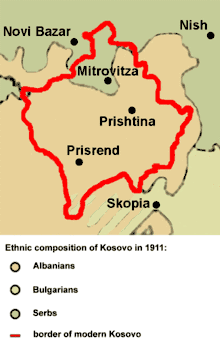
German scholar Gustav Weigand gave the following statistical data about the population of Kosovo,[64] based on the pre-war situation in Kosovo in 1912:
- Pristina District: 67% Albanians, 30% Serbs
- Prizren District: 63% Albanians, 36% Serbs
- Vučitrn District: 90% Albanians, 10% Serbs
- Ferizaj District: 70% Albanians, 30% Serbs
- Gnjilane District: 75% Albanians, 23% Serbs
- Mitrovica District: 60% Serbs, 40% Albanians
Metohija with the town of Gjakova is furthermore defined as almost exclusively Albanian by Weigand.[64]
Balkan Wars and First World War (Montenegro and Serbia)
Kosovo was part of the Ottoman Empire and following the Balkan Wars (1912–1913), the western part was included in Montenegro and the rest within Serbia.[65] Citing Serbian sources, Noel Malcolm also states that in 1912 when Kosovo came under Serbian control, "the Orthodox Serb population [was] at less than 25%" of Kosovo's entire population.[66]
Beginning from 1912, Montenegro initiated its attempts at colonisation and enacted a law on the process during 1914 that aimed at expropriating 55,000 hectares of Albanian land and transferring it to 5,000 Montenegrin settlers.[67] Some Serb colonisation of Kosovo took place during the Balkan Wars.[68] Serbia undertook measures for colonisation by enacting a decree aimed at colonists within "newly liberated areas" that offered 9 hectares of land to families.[67]
Yugoslav Interwar period
In the aftermath of the First World War Serbian control over Kosovo was restored and the Kingdom attempting to counteract Albanian separatism pursued a policy to alter the national and religious demographics of Kosovo and to Serbianise the area through colonisation.[69][70][71] Kosovo was an area where Serbs were not a majority population and the state sought demographic change in those areas through land reform and a colonisation policy.[72] A new decree issued in 1919 and later in 1920 restarted the colonisation process in places where Albanians lived in Kosovo and Vardar Macedonia.[67]
1921 census

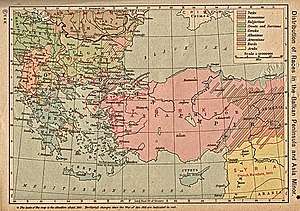
- The 1921 Kingdom of Serbs, Croats and Slovenes population census for the territories comprising modern day Kosovo listed 439,010 inhabitants:
- By religion:
- Muslims: 329,502 (75.1%)
- Eastern Orthodox Serbs: 93,203 (21.2%)
- Roman Catholics: 15,785 (3.6%)
- Jews: 427
- Greek Catholics: 26
- By native language:
- Albanian: 288,907 (65.8%)
- Serbian or Croatian: 114,095 (26.0%)
- Turkish: 27,915 (6.4%)
- Romanian-Cincarian: 402
- Slovene: 184
- German: 30
- Hungarian: 12
In the Yugoslav census of 1921, Albanians formed the majority population of Kosovo at around 64 percent with some 72 percent belonging to the Muslim faith.[71] Government sponsored colonisation of Kosovo and Vardar Macedonia was initiated in 1920 when on 24 September the Assembly of the Yugoslav Kingdom passed the Decree on the Colonisation of the Southern Provinces of Yugoslavia.[73][71][74] The decrees were intended as a reward to former soldiers and chetniks for their service during the Balkan Wars and World War One with incentives offered to settle in Kosovo that allowed them to claim between 5 and 10 hectares of land.[75][67][76] The military veterans that settled in Kosovo were known as dobrovoljac (volunteers) and were a politically reliable group for the state.[76] The colonisation process also entailed the arrival of Serbian bureaucrats to Kosovo along with their families.[76] During 1919–1928 some 13,000 to 15,914 Serbian families came to live in Kosovo as stipulated to the conditions of the decrees.[77] Between 1918 and 1923, as a result of state policies 30,000 and 40,000 mainly Muslim Albanians migrated to the Turkish regions of Izmir and Anatolia.[78]
1931 census
- According to the 1931 Kingdom of Yugoslavia population census, there were 552,064 inhabitants in today's Kosovo.
- By religion:
- Muslims: 379,981 (68.83%)
- Orthodox Serbs: 150,745 (27.31%)
- Roman Catholics: 20,568 (3.73%)
- Evangelists: 114 (0.02%)
- other: 656 (0.12%)
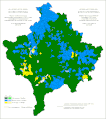 Religious structure of Kosovo and Metohija by settlements 1931 (territorial organization from 1961)
Religious structure of Kosovo and Metohija by settlements 1931 (territorial organization from 1961)
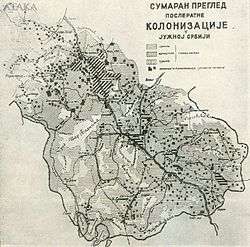
- By native language:
- Albanians: 331,549 (60.06%)
- Serbs, Croats, Slovenes and Macedonians: 180,170 (32.64%)
- Hungarians: 426 (0.08%)
- Germans: 241 (0.04%)
- other Slavs: 771 (0.14%)
- other: 38,907 (7.05%)
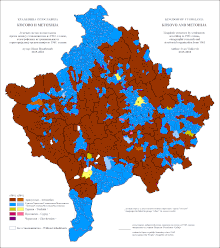 Linguistic structure of Kosovo and Metohija by settlements 1931 (territorial organization from 1961)
Linguistic structure of Kosovo and Metohija by settlements 1931 (territorial organization from 1961)
By the 1930s, the efforts and attempts at increasing the Serb population had failed as the Yugoslav census (1931) showed Albanians were 62 percent of the Kosovan population.[69][79][80] Colonisation had managed to partially change the demographic situation in Kosovo and the share of Albanians had decreased from 65 percent (289,000) in 1921 to 61 percent (337,272) in 1931 and Serbs increased from 28 percent (114,000) to 32 percent (178,848).[76] State authorities attempted to decrease the Albanian population through "forced migration", a process that grew during the decade.[69][79] The second phase of Yugoslav colonisation began in 1931, when the Decree on the Colonisation of the Southern Regions was issued on 11 July.[73][81] This phase of colonisation was considered unsuccessful because only 60 to 80 thousand people (some 17–20 thousand families) showed a willingness to become settlers and gained land, of whom many failed to follow through.[75][76]
Based in Ankara, the data gathered for 1919-1940 by the Yugoslav Legation shows 215,412 Albanians migrated to Turkey, whereas data collected by the Yugoslav army shows that until 1939, 4,046 Albanian families went to live in Albania.[82] For 1918 to 1921, Sabrina Ramet cites the estimate that the expulsions of Albanians reduced their numbers from around 800,000 – 1,000,000 within Kosovo down to some 439,500.[83] Between 1923-1939, some 115,000 Yugoslav citizens migrated to Turkey and both Yugoslavian and Turkish sources state that Albanians composed most of that population group.[84]
Albanian scholars from Albania and Kosovo place the number of Albanian refugees from 300,000 upward into the hundreds of thousands and state that they left Yugoslavia due to duress.[85][86][87] Other estimates given by scholars outside the Balkans for Kosovan Albanians that emigrated during 1918–1941 are between 90,000–150,000 or 200,000–300,000.[79][87] To date, access is unavailable to the Turkish Foreign Ministry archive regarding this issue and as such the total numbers of Albanians arriving to Turkey during the interwar period are difficult to determine.[85]
World War II
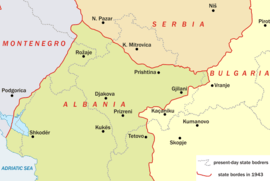
During World War II, a large area of Kosovo was attached to Italian controlled Albania.[88][89] Kosovo Albanians sought to redress the past policies of colonisation and slavisation and power relations between Albanians and Serbs were overturned in the new administration.[88][89] It resulted in local Serbs and other Serbs that had arrived previously as part of the colonisation plan to be targeted by groups of armed Albanians.[89] Campaigns aimed toward Serbs followed and included the destruction of property, killings, murders and deportations.[88][83][89] The majority of Montenegrin and Serb settlers consisting of bureaucrats and dobrovoljac fled from Kosovo to Axis occupied Serbia or Montenegro.[88][90] One estimate places the number of Serbs that were forced to leave at 70,000-100,000.[83] Serbian historiography estimates that some 100,000 Serbs left Kosovo during 1941–1945.[90] Other Serb sources place the number at 250,000.[91]
A three-dimensional conflict ensued, involving inter-ethnic, ideological, and international affiliations, with the first being most important. Nonetheless, these conflicts were relatively low-level compared with other areas of Yugoslavia during the war years, with one Serb historian estimating that 3,000 Albanians and 4,000 Serbs and Montenegrins were killed, and two others estimating war dead at 12,000 Albanians and 10,000 Serbs and Montenegrins.[92] An official investigation conducted by the Yugoslav government in 1964 recorded nearly 8,000 war-related fatalities in Kosovo between 1941 and 1945, 5,489 of whom were Serb and Montenegrin and 2,177 of whom were Albanian.[93]
Communist Yugoslavia
Following the Second World War and establishment of communist rule in Yugoslavia, the colonisation programme was discontinued, as President Tito wanted to avoid sectarian and ethnic conflicts.[94] Tito enacted a temporary decree in March 1945 that banned the return of colonists, which included some Chetniks and the rest that left during the war seeking refuge.[95][96] Two weeks later Tito issued another decree and followed it with a law in August 1945 that permitted a conditional return for a minority of the colonists.[95][96] In total, cases of return numbered 11,168, with 4,829 cases confirmed, 5,744 cases partially confirmed alongside 595 cases being denied.[95] A small proportion of the previous colonist population came back to Kosovo and repossessed land, with a greater part of their number (4,000 families) later leaving for other areas of Yugoslavia.[95]
After the Second World War and the Yugoslavia-Albania split, Yugoslav authorities attempted to downplay links between Albanians of Albania and Kosovo and to implement a policy of "Turkification" that encouraged Turkish language education and emigration to Turkey among Albanians.[97][98] In 1953, an agreement was reached between Tito and Mehmet Fuat Köprülü, the foreign minister of Turkey that promoted the emigration of Albanians to Anatolia.[97][98] Forced migration to Turkey increased and numbers cited by Klejda Mulaj for 1953–1957 are 195,000 Albanians leaving Yugoslavia and for 1966, some 230,000 people.[97] Historian Noel Malcolm placed the number of Albanians leaving for Turkey at 100,000 between 1953–1966.[98] Factors involved in the upsurge of migration were intimidation and pressure toward the Albanian population to leave through a campaign headed by Yugoslav police chief Aleksandar Ranković that officially was stated as aimed at curbing Albanian nationalism.[97][98] Kosovo under the control of Ranković was viewed by Turkey as the individual that would implement "the Gentleman's Agreement".[98] At the same time, a new phase of colonisation occurred in the region as Montenegrin and Serb families were installed in Kosovo.[97] The situation ended in 1966 with the removal of Ranković from his position.[97]
Censuses
1948 census
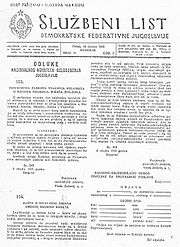
727,820 total inhabitants
- 498,242 Albanians (68.46%)
- 171,911 Serbs (23.62%)
- 28,050 Montenegrins (3.86%)
- 11,230 Roma (1.54%)
- 5,290 Croats (0.73%)
- 1,315 Turks (0.18%)
- 526 Macedonians (0.07%)
- 362 Russians (0.05%)
- 283 Slovenes (0.04%)
- 197 Germans (0.03%)
- 83 Hungarians (0.01%)
- 77 Bulgarians (0.01%)
- 39 Italians
- 31 Rusyns
- 29 Czechs
- 18 Romanians
- 2 Slovaks
- 9,679 undecided Muslims (1.33%)
- 456 other and unknown (0.06%)
1953 census
808,141 total inhabitants
1961 census
963,959 total inhabitants
- 646,604 Albanians (67.08%)
- 227,016 Serbs (23.55%)
- 37,588 Montenegrins (3.9%)
- 8,026 Ethnic Muslims (0.83%)
- 7,251 Croat (0.75%)
- 5,203 Yugoslavs (0.54%)
- 3,202 Romani (0.33%)
- 1,142 Macedonians (0.12%)
- 510 Slovenes (0.05%)
- 210 Hungarians (0.02%)
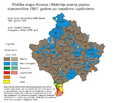 Ethnic structure of Kosovo and Metohija by settlements 1961.
Ethnic structure of Kosovo and Metohija by settlements 1961.- Ethnic structure of Kosovo and Metohija by settlements 1961.
- Ethnic structure of Kosovo and Metohija by settlements 1961.
 Ethnic structure of Kosovo and Metohija by settlements 1961.
Ethnic structure of Kosovo and Metohija by settlements 1961.- Distribution of Albanians on Kosovo and Metohija by settlements 1961.
- Distribution of Serbs on Kosovo and Metohija by settlements 1961.
 Distribution of Serbs on Kosovo and Metohija by settlements 1961.
Distribution of Serbs on Kosovo and Metohija by settlements 1961.- Distribution of Montenegrins on Kosovo and Metohija by settlements 1961.
- Distribution of Croats on Kosovo and Metohija by settlements 1961.
1971 census
1,243,693 total inhabitants
- 916,168 Albanians or 73.7%[91]
- 228,264 Serbs (18.4%)
- 31,555 Montenegrins (2.5%)
- 26,000 Slavic Muslims (2.1%)
- 14,593 Romani (1.2%)
- 12,244 Turks (1.0%)
- 8,000 Croats (0.7%)
- 920 Yugoslavs (0.1%)
- Ethnic structure of Kosovo and Metohija by settlements 1971.
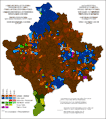 Ethnic structure of Kosovo and Metohija by settlements 1971.
Ethnic structure of Kosovo and Metohija by settlements 1971.- Ethnic structure of Kosovo and Metohija by settlements 1971.
 Distribution of Albanians on Kosovo and Metohija by settlements 1971.
Distribution of Albanians on Kosovo and Metohija by settlements 1971.- Distribution of Albanians on Kosovo and Metohija by settlements 1971.
- Distribution of Serbs on Kosovo and Metohija by settlements 1971.
- Distribution of Montenegrins on Kosovo and Metohija by settlements 1971.
- Distribution of Muslims on Kosovo and Metohija by settlements 1971.
1981 census
1,584,558 total inhabitants[99]
- 1,226,736 Albanians (77.42%)
- 209,498 Serbs (13.2%)
- 27,028 Montenegrins (1.7%)
- 2,676 Yugoslavs (0.2%)
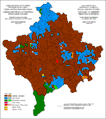 Ethnic structure of Kosovo and Metohija by settlements 1981.
Ethnic structure of Kosovo and Metohija by settlements 1981.- Ethnic structure of Kosovo and Metohija by settlements 1981.
 Ethnic structure of Kosovo and Metohija by settlements 1981.
Ethnic structure of Kosovo and Metohija by settlements 1981.- Distribution of Albanians on Kosovo and Metohija by settlements 1981.
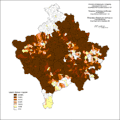 Distribution of Albanians on Kosovo and Metohija by settlements 1981.
Distribution of Albanians on Kosovo and Metohija by settlements 1981.- Distribution of Serbs on Kosovo and Metohija by settlements 1981.
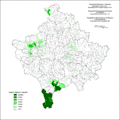 Distribution of Muslims on Kosovo and Metohija by settlements 1981.
Distribution of Muslims on Kosovo and Metohija by settlements 1981.- Distribution of Montenegrins on Kosovo and Metohija by settlements 1981.
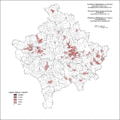 Distribution of Roma on Kosovo and Metohija by settlements 1981.
Distribution of Roma on Kosovo and Metohija by settlements 1981. Ethnic composition of Kosovo in 1981 with Serb enclaves shown as in 2011
Ethnic composition of Kosovo in 1981 with Serb enclaves shown as in 2011
1991 census
Registered population
Official Yugoslav statistical results, almost all Albanians and some Roma and Muslims boycotted the census following a call by Ibrahim Rugova to boycott Serbian institutions.
359,346 total inhabitants[99]
By ethnicity:
- 194,190 Serbs
- 57,758 Muslims (minority boycotted)
- 44,307 Roma (minority boycotted)
- 20,356 Montenegrins
- 9,091 Albanians (majority boycotted)
- 10,446 Turks
- 8,062 Croats (Janjevci, Letnicani)
- 3,457 Yugoslavs
- Ethnic structure of Kosovo and Metohija by settlements 1991 (registered population)
- Distribution of Roma in Kosovo and Metohija by settlements 1991.
- By religion:
- 216,742 (60,32%) Orthodox
- 126,577 (35,22%) Muslims
- 9,990 (2,78%) Catholics
- 1,036 (0,29) Atheist
- 4,417 (1,23) Unknown
 Religious structure of Kosovo and Metohija by settlements 1991. (registered population)
Religious structure of Kosovo and Metohija by settlements 1991. (registered population)
Estimated population
Statistical office of Autonomous Province of Kosovo and Metohija estimated total number of Albanians, Muslims and Roma.
1,956,196 total inhabitants
By ethnicity:
- 1,596,072 Albanians (81.6%)
- 194,190 Serbs (9.9%)
- 66,189 Muslims (3.4%)
- 45,745 Roma (2.34%)
- 20,365 Montenegrins (1.04%)
- 10,445 Turks (0.53%)
- 8,062 Croats (Janjevci, Letnicani) (0.41)
- 3,457 Yugoslavs (0.18%)
- 11,656 others (0.6%)
- Ethnic structure of Kosovo and Metohija by settlements 1991
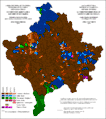 Ethnic structure of Kosovo and Metohija by settlements 1991
Ethnic structure of Kosovo and Metohija by settlements 1991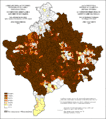 Share of Albanians on Kosovo and Metohija by settlements 1991
Share of Albanians on Kosovo and Metohija by settlements 1991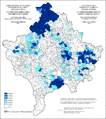 Share of Serbs on Kosovo and Metohija by settlements 1991
Share of Serbs on Kosovo and Metohija by settlements 1991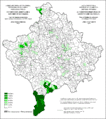 Share of Muslims on Kosovo and Metohija by settlements 1991
Share of Muslims on Kosovo and Metohija by settlements 1991.png) Ethnic map of Kosovo, 1991 data
Ethnic map of Kosovo, 1991 data
The corrections should not be taken to be fully accurate. The number of Albanians is sometimes regarded as being an underestimate. On the other hand, it is sometimes regarded as an overestimate, being derived from earlier censa which are believed to be overestimates. The Statistical Office of Kosovo states that the quality of the 1991 census is "questionable." .
In September 1993, the Bosniak parliament returned their historical name Bosniaks. Some Kosovar Muslims have started using this term to refer to themselves since.
Milošević government (1990s)
By 1992, the situation in Kosovo deteriorated and politicians from both sides were at an impasse toward solutions for the future of the region.[100] Concerns increased among Serbs and an organisation was created called the Serb Block for Colonizing Kosovo in Pristina that aimed to get state officials based in Belgrade to raise the Serb population within Kosovo.[100] As such, the state made available loans for building apartments and homes along with employment opportunities for Montenegrins and Serbs that chose to relocate to the region.[100] In March 1992, nearly 3,000 people from the Serb minority in Albania had emigrated to Kosovo after accepting the government offer.[100] At the time, the government under President Slobodan Milošević pursued colonisation amidst a situation of financial difficulties and limited resources.[100] Laws were passed by the parliament of Serbia that sought to change the power balance in Kosovo relating to the economy, demography and politics.[101] The parliament of Serbia on 11 January 1995 passed the Decree for Colonisation of Kosovo of the Federal Republic of Yugoslavia.[102] It outlined government benefits for Serbs who desired to go and live in Kosovo with loans to build homes or purchase other dwellings and offered free plots of land.[102][101] Few Serbs took up the offer due to the worsening situation in Kosovo at the time.[102]
Around 10,000 Serb refugees from Krajina and over 2000 from Bosnia were resettled in Kosovo, due to the Yugoslav Wars.[103] In 1995, the government attempted to alter the ethnic balance of the region through the planned resettlement of 100,000, later reduced to 20,000 Serbian refugees from Krajina in Croatia to Kosovo.[103][104] Some of the Serb refugees opposed going to Kosovo.[104] In 1996, official government statistics placed the number of refugees in Kosovo at 19,000.[104] Most of the Serb refugees left thereafter and a few remained.[102] In early 1997, the number of resettled Serb refugees in Kosovo was 4,000[104] and 6,000 in early 1999.[105] As the sociopolitical situation deteriorated, Kosovo Albanians numbering some 300,000 fled during this period for Western Europe.[106] After the outbreak of conflict between the Milošević government and the Kosovo Liberation Army, in early 1997, an estimated 9,000 Serb refugees and 20,000 local Serbs left Kosovo.[107]
Kosovo War (1999)
During the Kosovo war (March–June 1999), Serb forces expelled between 800,000 – 1,000,000 Albanians from Kosovo employing tactics such as confiscating personal documents to make it difficult or prevent any future return.[108] Kosovo Albanians later returned following NATO intervention and the end of the war.
In 1999 more than 11,000 deaths were reported to the office of the International Criminal Tribunal for the former Yugoslavia prosecutor Carla Del Ponte.[109] Around 10,317 civilians in total were killed during the war, of whom 8,676 were Albanians, 1,196 Serbs and 445 Roma and others in addition to 3,218 killed members of armed formations.[110] As of 2010, some 3,000 people were still missing, of which 2,500 are Albanian, 400 Serbs and 100 Roma.[111]
In the days after the Yugoslav Army withdrew, over 80,000 (almost half of 200,000 estimated to live in Kosovo) Serb and other non-Albanians civilians were expelled from Kosovo.[112][113][114][115][116] Estimates of the number of Serbs who left when Serbian forces departed from Kosovo vary from 65,000[117] to 250,000.[118] In addition, less than one hundred of the Serb refugees from Croatia remained in Kosovo.[105]
Modern period
2011 census
In the 2011 census there were 1,739,825 inhabitants. ECMI "calls for caution when referring to the 2011 census", due to the boycott by Serb-majority municipalities in North Kosovo and the partial boycott by Serb and Roma in southern Kosovo.[119] According to the data, this is the ethnic composition of Kosovo:
- Albanians: 1,616,869 (92.9%)
- Serbs*: 25,532 (1.5%)
- Bosniaks: 27,553 (1.6%)
- Turks: 18,738 (1.1%)
- Ashkali: 15,436 (0.9%)
- Egyptians: 11,524 (0.6%)
- Gorani: 10,265 (0.6%)
- Romani: 8,824 (0.5%)
- Other: 2352 (0.1%)
- Unspecified: 2752 (0.1%)
- Kosovo ethnic map 2011 by settlement.
- Distribution of Albanians in Kosovo 2011 by settlements.
- Distribution of Serbs in Kosovo 2011 by settlements.
- Distribution of Bosniaks in Kosovo 2011 by settlements.
- Distribution of Turks in Kosovo 2011 by settlements.
- Distribution of Gorani's in Kosovo 2011 by settlements.
- Distribution of Roma, Ashkali and Egyptians in Kosovo 2011 by settlements.
See also
References
- Pannonia and Upper Moesia: a history of the middle Danube provinces of the Roman EmpireThe Provinces of the Roman Empire, Vol. 4, ISBN 0710077149, 9780710077141, 1974, page 9
- Wilkes, J. J. The Illyrians, 1992, ISBN 0-631-19807-5, page 85, "Whether the Dardanians were an Illyrian or a Thracian people has been much debated and one view suggests that the area was originally populated with Thracians who then exposed to direct contact with illyrians over a long period."
- The central Balkan tribes in pre-Roman times: Triballi, Autariatae, Dardani, Scordisci and Moesians by Fanula Papazoglu, ISBN 90-256-0793-4, page 265
- N G Hammond, The Kingdoms of Illyria c. 400 – 167 BC. Collected Studies, Vol 2, 1993
- "the Dardanians [...] living in the frontiers of the Illyrian and the Thracian worlds retained their individuality and, alone among the peoples of that region succeeded in maintaining themselves as an ethnic unity even when they were militarily and politically subjected by the Roman arms [...] and when at the end of the ancient world, the Balkans were involved in far-reaching ethnic perturbations, the Dardanians, of all the Central Balkan tribes, played the greatest part in the genesis of the new peoples who took the place of the old" – The central Balkan tribes in pre-Roman times: Triballi, Autariatae, Dardanians, Scordisci and Moesians, Amsterdam 1978, by Fanula Papazoglu, ISBN 90-256-0793-4, p. 131.
- Hauptstädte in Südosteuropa: Geschichte, Funktion, nationale Symbolkraft by Harald Heppner, page 134
- Curta 2001, p. 189.
- By Procopius of Caesarea 500 - 554 AD History of the Wars, Book VII https://books.google.no/books/about/Procopius_History_of_the_wars_Books_VII.html?id=kTgjAQAAMAAJ&redir_esc=y
- The plague pandemic and Slavic expansion in the 6th-8th centuries
- Kosovo: A Short History - page 23, Origins: Serbs , Albanians and Vlachs
- Noel Malcolm - Kosovo: A Short history page - 27
- Noel Malcolm - Kosovo: A short history, page 28.
- Fine 1994, p. 7
the Hungarian attack launched in 1183 with which Nemanja was allied [...] was able to conquer Kosovo and Metohija, including Prizren.
- Madgearu, Alexandru; Gordon, Martin (2008). The Wars of the Balkan Peninsula: Their Medieval Origins. Scarecrow Press. p. 25. ISBN 978-0-8108-5846-6.
- Madgearu, Alexandru; Gordon, Martin (2008). The Wars of the Balkan Peninsula: Their Medieval Origins. Scarecrow Press. pp. 26–27. ISBN 978-0-8108-5846-6.
- Madgearu. The Wars of the Balkan Peninsula. Page 33.
- Kosovo: A Short History by Noel Malcolm
- Have the Albanians invaded Kosova? - Alain Ducellier page 33-34
- Kosovo: A Short History
- A.Hanzic - Nekoliko vijesti o Arbanasima na Kosovu I Metohiji v sredinom XV vijeka pp.201-9
- Milan Sufflay: Povijest Sjevernih Arbanasa pp. 61-2
- Crampton, R. J. (2005). A Concise History of Bulgaria (2nd ed.). Cambridge University Press. p. 15.
- Fine, John Van Antwerp (1994), The Late Medieval Balkans: A Critical Survey from the Late Twelfth Century to the Ottoman Conquest, University of Michigan Press, p. 318, ISBN 978-0-472-08260-5
- Malcolm, Noel (1998). Kosovo: A short history. Macmillan. p. 54. ISBN 9780810874831. "From the details of the monastic estates given in the chrysobulls, further information can be gleaned about these Vlachs and Albanians. The earliest reference is in one of Nemanja’s charters giving property to Hilandar, the Serbian monastery on Mount Athos: 170 Vlachs are mentioned, probably located in villages round Prizren. When Dečanski founded his monastery of Decani in 1330, he referred to 'villages and katuns of Vlachs and Albanians' in the area of the white Drin: a katun (alb.:katund) was a shepherding settlement. And Dusan’s chrysobull of 1348 for the Monastery of the Holy Archangels in Prizren mentions a total of nine Albanian katuns."
- Wilkinson, Henry Robert (1955). "Jugoslav Kosmet: The evolution of a frontier province and its landscape". Transactions and Papers (Institute of British Geographers). 21 (21): 183. JSTOR 621279.CS1 maint: ref=harv (link) "The monastery at Dečani stands on a terrace commanding passes into High Albania. When Stefan Uros III founded it in 1330, he gave it many villages in the plain and catuns of Vlachs and Albanians between the Lim and the Beli Drim. Vlachs and Albanians had to carry salt for the monastery and provide it with serf labour."
- Kosovo: A Short History
- In 1972 the Sarajevo Institute of Middle Eastern Studies translated the original Turkish census and published an analysis of it Kovačević Mr. Ešref, Handžić A., Hadžibegović H. Oblast Brankovića – Opširni katastarski popis iz 1455., Orijentalni institut, Sarajevo 1972. Subsequently others have covered the subject as well such as Vukanović Tatomir, Srbi na Kosovu, Vranje, 1986.
- "Oblast Brankovica Opsirni Katastarski Popis Iz 1455 Godine".
- (PDF) http://www.eparhija-prizren.com/sites/default/files/users/4/brankovici_popis_pregled.pdf. Missing or empty
|title=(help) - Madgearu, Alexandru; Gordon, Martin (2008). The Wars of the Balkan Peninsula: Their Medieval Origins. Scarecrow Press. p. 27. ISBN 978-0-8108-5846-6.
- Anscombe, Frederick (2006). "The Ottoman Empire in Recent International Politics – II: The Case of Kosovo" (PDF). The International History Review. 28 (4): 785. doi:10.1080/07075332.2006.9641103. JSTOR 40109813.CS1 maint: ref=harv (link) "While the ethnic roots of some settlements can be determined from the Ottoman records, Serbian and Albanian historians have at times read too much into them in their running dispute over the ethnic history of early Ottoman Kosovo. Their attempts to use early Ottoman provincial surveys (tahrir defterleri) to gauge the ethnic make-up of the population in the fifteenth century have proved little."
- Varia turcica IV. Comité international d'etudes pré-Ottomanes et Ottomanes. VIth Symposium Cambridge, 1-4t July 1984, Istanbul-Paris-Leiden 1987, pp. 105–114
- TKGM, TD № 55 (412), (Defter sandžaka Prizren iz 1591. godine).
- Anscombe, Frederick F, (2006). "The Ottoman Empire in Recent International Politics – II: The Case of Kosovo". The International History Review. 28.(4): 767–774, 785–788. "While the ethnic roots of some settlements can be determined from the Ottoman records, Serbian and Albanian historians have at times read too much into them in their running dispute over the ethnic history of early Ottoman Kosovo. Their attempts to use early Ottoman provincial surveys (tahrir defterleri) to gauge the ethnic make—up of the population in the fifteenth century have proved little. Leaving aside questions arising from the dialects and pronunciation of the census scribes, interpreters, and even priests who baptized those recorded, no natural law binds ethnicity to name. Imitation, in which the customs, tastes, and even names of those in the public eye are copied by the less exalted, is a time—tested tradition and one followed in the Ottoman Empire. Some Christian sipahis in early Ottoman Albania took such Turkic names as Timurtaş, for example, in a kind of cultural conformity completed later by conversion to Islam. Such cultural mimicry makes onomastics an inappropriate tool for anyone wishing to use Ottoman records to prove claims so modern as to have been irrelevant to the pre—modern state. The seventeenth—century Ottoman notable arid author Evliya Çelebi, who wrote a massive account of his travels around the empire and abroad, included in it details of local society that normally would not appear in official correspondence; for this reason his account of a visit to several towns in Kosovo in 1660 is extremely valuable. Evliya confirms that western and at least parts of central Kosovo were 'Arnavud'. He notes that the town of Vučitrn had few speakers of 'Boşnakca'; its inhabitants spoke Albanian or Turkish. He terms the highlands around Tetovo (in Macedonia), Peć, and Prizren the 'mountains of Arnavudluk'. Elsewhere, he states that 'the mountains of Peć' lay in Arnavudluk, from which issued one of the rivers converging at Mitrovica, just north-west of which he sites Kosovo’s border with Bosna. This river, the Ibar, flows from a source in the mountains of Montenegro north—north—west of Peć, in the region of Rozaje to which the Këlmendi would later be moved. He names the other river running by Mitrovica as the Kılab and says that it, too, had its source in Aravudluk; by this he apparently meant the Lab, which today is the name of the river descending from mountains north—east of Mitrovica to join the Sitnica north of Priština. As Evliya travelled south, he appears to have named the entire stretch of river he was following the Kılab, not noting the change of name when he took the right fork at the confluence of the Lab and Sitnica. Thus, Evliya states that the tomb of Murad I, killed in the battle of Kosovo Polje, stood beside the Kılab, although it stands near the Sitnica outside Priština. Despite the confusion of names, Evliya included in Arnavudluk not only the western fringe of Kosovo, but also the central mountains from which the Sitnica ('Kılab') and its first tributaries descend. Given that a large Albanian population lived in Kosovo, especially in the west and centre, both before and after the Habsburg invasion of 1689–90, it remains possible, in theory, that at that time in the Ottoman Empire, one people emigrated en masse and another immigrated to take its place.
- Malcolm, Noel (1998). Kosovo: A short history. Macmillan. p. 114. "What a straightforward reading of all this evidence would suggest is that there were significant reservoirs of a mainly Catholic Albanian-speaking population in parts of Western Kosovo, and evidence from the following century suggests that many of these eventually became Muslims. Whether Albanian-speakers were a majority in Western Kosovo at this time seems very doubtful, and it is clear that they were only a small minority in the east. On the other hand, it is also clear that the Albanian minority in Eastern Kosovo predated the Ottoman conquest."
- Jagodić 1998, para. 10, 12.
- Geniş, Şerife, and Kelly Lynne Maynard (2009). "Formation of a diasporic community: The history of migration and resettlement of Muslim Albanians in the Black Sea Region of Turkey." Middle Eastern Studies. 45. (4): 556–557: Using secondary sources, we establish that there have been Albanians living in the area of Nish for at least 500 years, that the Ottoman Empire controlled the area from the fourteenth to nineteenth centuries which led to many Albanians converting to Islam, that the Muslim Albanians of Nish were forced to leave in 1878, and that at that time most of these Nishan Albanians migrated south into Kosovo, although some went to Skopje in Macedonia. ; pp. 557–558. In 1690 much of the population of the city and surrounding area was killed or fled, and there was an emigration of Albanians from the Malësia e Madhe (North Central Albania/Eastern Montenegro) and Dukagjin Plateau (Western Kosovo) into Nish.
- Casiday, Augustine (2012), The Orthodox Christian World (PDF), Routledge, p. 135
- Noel Malcolm, Kosovo, A Short History pp.139–171
- Malcolm, Noel (1998). Kosovo: a short history. Macmillan. p. 162. ISBN 978-0-333-66612-8.CS1 maint: ref=harv (link)
- Pahumi, Nevila (2007). "The Consolidation of Albanian Nationalism". Page 18: "The pasha of Ipek forcibly removed Catholic inhabitants of northern Albania into the plains of southern Serbia after a failed Serb revolt in 1689 and the flight of many Serbs to the Habsburg Empire. The transferred villagers were forced to convert over to Islam."
- Kosovo: A Short History
- Kosovo: A Short History - Noel Malcolm
- H.R. Wilkinson, Maps and Politics; a review of the ethnographic cartography of Macedonia, Liverpool University Press, 1951
- ISBN 86-17-09287-4: Kosta Nikolić, Nikola Žutić, Momčilo Pavlović, Zorica Špadijer: Историја за трећи разред гимназије, Belgrade, 2002, pg. 63
- Detailbeschreibung des Sandzaks Plevlje und des Vilajets Kosovo (Mit 8 Beilagen und 10 Taffeln), Als Manuskript gedruckt, Vien 1899, 80–81.
- Pllana, Emin (1985). "Les raisons de la manière de l'exode des refugies albanais du territoire du sandjak de Nish a Kosove (1878–1878) [The reasons for the manner of the exodus of Albanian refugees from the territory of the Sanjak of Niš to Kosovo (1878–1878)] ". Studia Albanica. 1: 189–190.
- Rizaj, Skënder (1981). "Nënte Dokumente angleze mbi Lidhjen Shqiptare të Prizrenit (1878–1880) [Nine English documents about the League of Prizren (1878–1880)]". Gjurmine Albanologjike (Seria e Shkencave Historike). 10: 198.
- Şimşir, Bilal N, (1968). Rumeli’den Türk göçleri. Emigrations turques des Balkans [Turkish emigrations from the Balkans]. Vol I. Belgeler-Documents. p. 737.
- Bataković, Dušan (1992). The Kosovo Chronicles. Plato.
- Elsie, Robert (2010). Historical Dictionary of Kosovo. Scarecrow Press. p. XXXII. ISBN 9780333666128.
- Stefanović, Djordje (2005). "Seeing the Albanians through Serbian eyes: The Inventors of the Tradition of Intolerance and their Critics, 1804–1939." European History Quarterly. 35. (3): 470.
- Jagodić 1998, para. 29.
- Jagodić 1998, para. 31.
- Uka, Sabit (2004a). Dëbimi i Shqiptarëve nga Sanxhaku i Nishit dhe vendosja e tyre në Kosovë:(1877/1878-1912) [The expulsion of the Albanians from Sanjak of Nish and their resettlement in Kosovo: (1877/1878-1912)]. Prishtina: Verana. pp. 194–286. ISBN 9789951864503.CS1 maint: ref=harv (link)
- Osmani 2000, pp. 48–50.
- Osmani 2000, pp. 44–47, 50–51, 54–60.
- Jagodić, Miloš (1998). "The Emigration of Muslims from the New Serbian Regions 1877/1878". Balkanologie. 2 (2).CS1 maint: ref=harv (link) para. 30.
- Osmani, Jusuf (2000). Kolonizimi Serb i Kosovës [Serbian colonization of Kosovo]. Era. pp. 43–64. ISBN 9789951040525.CS1 maint: ref=harv (link)
- Malcolm, Noel (1998). Kosovo: A short history. London: Macmillan. pp. 228–229. ISBN 9780333666128.CS1 maint: ref=harv (link) "Precise figures are lacking, but one modern study concludes that the whole region contained more than 110,000 Albanians. By the end of 1878 Western officials were reporting that there were 60,000 families of Muslim refugees in Macedonia, 'in a state of extreme destitution', and 60–70,000 Albanian refugees from Serbia 'scattered' over the vilayet of Kosovo.... All these new arrivals were known as muhaxhirs (Trk.: muhacir Srb.: muhadžir), a general word for Muslim refugees. The total number of those who settled in Kosovo is not known with certainty: estimates ranged from 20,000 to 50,000 for Eastern Kosovo, while the governor of the vilayet gave a total of 65,000 in 1881, some of whom were in the sancaks of Skopje and Novi Pazar. At a rough estimate, 50,000 would seem a reasonable figure for those muhaxhirs of 1877–8 who settled in the territory of Kosovo itself. Apart from the Albanians, smaller numbers of Muslim Slavs came from Montenegro and Bosnia."
- Gawrych 2006, p. 34.
- Gawrych 2006, p. 35.
- Gawrych, George (2006). The Crescent and the Eagle: Ottoman rule, Islam and the Albanians, 1874–1913. London: IB Tauris. pp. 30, 34. ISBN 9781845112875.CS1 maint: ref=harv (link)
- Gustav Weigand, Ethnographie von Makedonien, Leipzig, 1924; Густав Вайганд, Етнография на Македония (Bulgarian translation)
- Qirezi 2017, pp. 38, 45, 53
- "Is Kosovo Serbia? We ask a historian". The Guardian. 26 February 2008. Retrieved 24 March 2014.
- Qirezi 2017, p. 53
- Hadri, Ali (1967). "Kosovo i Metohija u Kraljevini Jugoslaviji". Istorijski Glasnik (1–2): 59–60.CS1 maint: ref=harv (link)
- Karoubi, Mohammad Taghi (2017). Just or Unjust War?: International Law and Unilateral Use of Armed Force by States at the Turn of the 20th Century. Routledge. pp. 175–176. ISBN 9781351154666.CS1 maint: ref=harv (link)
- Iseni 2008, p. 312.
- Leurdijk & Zandee 2001, p. 13
- Gulyás & Csüllög 2015, pp. 230–231
- Bokovoy, Melissa (2001). "Scattered Graves, Ordered Cemeteries: Commemorating Serbia's Wars of National Liberation, 1912–1918". In Bucur, Maria; Wingfield, Nancy M. (eds.). Staging the Past: The Politics of Commemoration in Habsburg Central Europe, 1848 to the Present. Purdue University Press. p. 254. ISBN 9781557531612.CS1 maint: ref=harv (link)
- Boškovska 2017, pp. 163–164.
- Clark, Howard (2000). Civil resistance in Kosovo. Pluto Press. p. 10. ISBN 9780745315690.CS1 maint: ref=harv (link)
- Gulyás & Csüllög 2015, p. 231
- Qirezi 2017, pp. 53–54
- Iseni 2008, p. 313.
- Leurdijk, Dick; Zandee, Dick (2001). Kosovo: From crisis to crisis. Routledge. p. 14. ISBN 9781351791571.CS1 maint: ref=harv (link)
- Boškovska 2017, p. 168
- Boškovska, Nada (2017). Yugoslavia and Macedonia Before Tito: Between Repression and Integration. Bloomsbury Publishing. p. 164. ISBN 9781786730732.CS1 maint: ref=harv (link)
- Qirezi 2017, p. 47
- Ramet, Sabrina P. (1995). Social currents in Eastern Europe: The sources and consequences of the great transformation. Duke University Press. p. 198. ISBN 9780822315483.CS1 maint: ref=harv (link)
- Gingeras 2009, p. 161.
- Gingeras, Ryan (2009). Sorrowful Shores: Violence, Ethnicity, and the End of the Ottoman Empire 1912–1923. Oxford: Oxford University Press. p. 164.CS1 maint: ref=harv (link).
- Iseni, Bashkim (2008). La question nationale en Europe du Sud-Est: genèse, émergence et développement de l'indentité nationale albanaise au Kosovo et en Macédoine. Peter Lang. pp. 312–313. ISBN 9783039113200.CS1 maint: ref=harv (link)
- Mulaj 2008, p. 69
- Sullivan, Brian (1999). "The Balkans: Of What is Past, or Passing, or to Come". In Murray, Williamson (ed.). The Emerging Strategic Environment: Challenges of the Twenty-first Century. Praeger Publishers. p. 15. ISBN 9780275965730.CS1 maint: ref=harv (link)
- Cakaj, Gent; Krasniqi, Gëzim (2017). "The role of Minorities in the Serbo-Albanian Quagmire". In Mehmeti, Leandrit I.; Radeljić, Branislav (eds.). Kosovo and Serbia: Contested Options and Shared Consequences. University of Pittsburgh Press. pp. 154–155. ISBN 9780822981572.CS1 maint: ref=harv (link)
- Gulyás, László; Csüllög, Gábor (2015). "History of Kosovo from the First Balkan War to the End of World War II (1912 –1945" (PDF). West Bohemian Historical Review (2): 236.CS1 maint: ref=harv (link)
- Annexe I Archived 1 March 2003 at the Wayback Machine, by the Serbian Information Centre-London to a report of the Select Committee on Foreign Affairs of the House of Commons of the Parliament of the United Kingdom.
- Malcolm, Noel Kosovo: A Short History, p.312
- Frank, Chaim (2010). Petersen, Hans-Christian; Salzborn, Samuel (eds.). Antisemitism in Eastern Europe: History and Present in Comparison. Bern: Peter Lang. pp. 97–98. ISBN 978-3-631-59828-3.
- Sells, Michael Anthony (1996). The bridge betrayed: Religion and Genocide in Bosnia. University of California Press. p. 54. ISBN 9780520922099.CS1 maint: ref=harv (link)
- Qirezi 2017, p. 49
- Lampe, John R. (2000). Yugoslavia as History: Twice there was a Country. Cambridge University Press. p. 228. ISBN 9780521774017.CS1 maint: ref=harv (link)
- Mulaj, Klejda (2008). Politics of ethnic cleansing: nation-state building and provision of in/security in twentieth-century Balkans. Lexington Books. p. 45. ISBN 9780739146675.CS1 maint: ref=harv (link)
- Qirezi 2017, p. 50
- Bugajski, Janusz (2002). Political Parties of Eastern Europe: A Guide to Politics in the Post-Communist Era. New York: The Center for Strategic and International Studies. p. 479. ISBN 1563246767.
- Janjić, Dušan; Lalaj, Anna; Pula, Besnik (2013). "Kosovo under the Milošević Regime". In Ingrao, Charles W.; Emmert, Thomas A. (eds.). Confronting the Yugoslav Controversies: A Scholars' Initiative. Purdue University Press. p. 290. ISBN 9781557536174.CS1 maint: ref=harv (link)
- Mertus, Julie A. (2009). "Operation allied force: Handmaiden of independent Kosovo". International Affairs. 85 (3): 466. doi:10.1111/j.1468-2346.2009.00808.x.CS1 maint: ref=harv (link) "The Serbian parliament proceeded to pass a series of laws designed to reshape the demographic, economic and political balance of power in Kosovo. In an attempted 'Serbization' programme, tens of thousands of Kosovo Albanian doctors, municipal officials, teachers and industrial workers were sacked from their jobs, while ethnic Serbs were given economic incentives to live in Kosovo. The Serbian government replaced local Albanian police officers with special police units from the Serbian Ministry of the Interior."
- Bellamy, Alex J. (2012). "Human wrongs in Kosovo, 1974–99". In Booth, Ken (ed.). The Kosovo Tragedy: The Human Rights Dimensions. Routledge. p. 115. ISBN 9781136334764.CS1 maint: ref=harv (link)
- "Chronology for Kosovo Albanians in Serbia". University of Mariland. Retrieved 21 January 2013.
- van Selm, Joanne (2000). Kosovo's Refugees in the European Union. Continuum International Publishing Group. pp. 4–5. ISBN 978-1-85567-641-1.CS1 maint: ref=harv (link)
- "Abuses against Serbs and Roma in the new Kosovo". Human Rights Watch. August 1999. para. 35.
- Qirezi 2017, p. 51
- OSCE (1999). "Kosovo/Kosova, As Seen, As Told, An analysis of the human rights findings of the OSCE Kosovo Verification Mission, October 1998 to June 1999". OSCE Office for Democratic Institutions and Human Rights. p. 226.CS1 maint: ref=harv (link)
- Qirezi, Arben (2017). "Settling the self-determination dispute in Kosovo". In Mehmeti, Leandrit I.; Radeljić, Branislav (eds.). Kosovo and Serbia: Contested Options and Shared Consequences. University of Pittsburgh Press. pp. 51–53. ISBN 9780822981572.CS1 maint: ref=harv (link)
- "World: Europe UN gives figure for Kosovo dead". BBC News. 10 November 1999. Archived from the original on 20 April 2010. Retrieved 5 January 2010.
- http://www.kosovomemorybook.org/wp-content/uploads/2015/02/Expert_Evaluation_of_Kosovo_Memory_Book_Database_Prishtina_04_02_2015.pdf
- KiM Info-Service (7 June 2000). "3,000 missing in Kosovo". BBC News. Archived from the original on 20 April 2010. Retrieved 5 January 2010.
- "Abuses against Serbs and Roma in the new Kosovo". Human Rights Watch. August 1999. Archived from the original on 2 September 2012.
- "After Yugoslavia: Identities and Politics Within the Successor States". 2012. p. 30.
- "Kosovo Crisis Update". UNHCR. 4 August 1999. Archived from the original on 16 October 2015.
- "Forced Expulsion of Kosovo Roma, Ashkali and Egyptians from OSCE Participated state to Kosovo". OSCE. 6 October 2006. Archived from the original on 26 November 2015.
- Siobhán Wills (26 February 2009). Protecting Civilians: The Obligations of Peacekeepers. Oxford University Press. p. 219. ISBN 978-0-19-953387-9.
- European Stability Initiative (ESI): The Lausanne Principle: Multiethnicity, Territory and the Future of Kosovo's Serbs (.pdf) Archived 24 March 2009 at the Wayback Machine, 7 June 2004.
- Coordinating Centre of Serbia for Kosovo-Metohija: Principles of the program for return of internally displaced persons from Kosovo and Metohija.
- "ECMI: Minority figures in Kosovo census to be used with reservations". ECMI.
Sources
- Curta, Florin (2001). The Making of the Slavs: History and Archaeology of the Lower Danube Region, c. 500–700. Cambridge: Cambridge University Press. ISBN 9781139428880.CS1 maint: ref=harv (link)
- Curta, Florin (2006). Southeastern Europe in the Middle Ages, 500–1250. Cambridge: Cambridge University Press. ISBN 9780521815390.CS1 maint: ref=harv (link)